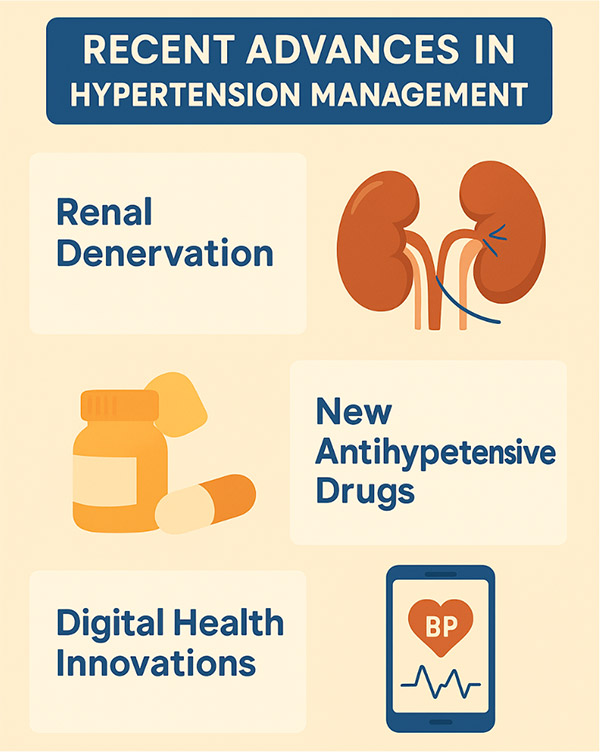Executive Summary:
Hypertension (HTN) remains a major global health burden, leading to cardiovascular morbidity and mortality worldwide. While lifestyle modification and pharmacologic therapy remain first-line strategies, a subset of patients continue to exhibit resistant hypertension, prompting exploration of new pharmacological agents and device-based interventions.
Among recent advances, renal denervation (RDN), a minimally invasive procedure, has emerged as a promising therapy for resistant hypertension. RDN involves catheter-based ablation of renal sympathetic nerves to reduce excessive sympathetic activity, a key contributor to high blood pressure (BP).
Recent clinical trials, such as SPYRAL HTN-ON MED, SPYRAL HTN-OFF MED, and RADIANCE-HTN have demonstrated significant BP reductions with RDN. Improved catheter designs and refined procedural techniques enhance precision, minimizing complications.
Beyond RDN, advances in antihypertensive drug development, such as dual endothelin receptor antagonists (e.g., aprocitentan) and aldosterone synthase inhibitors, as well as mineralocorticoid receptor antagonists, are offering new pathways for blood pressure control.
In an era of precision medicine, digital health innovations—such as remote BP monitoring, AI-driven therapeutic guidance, and mobile adherence tools—are augmenting traditional management approaches.
In summary, precision medicine and device-based therapies promise to revolutionize hypertension care, reducing cardiovascular risks and improving patient quality of life.

Hypertension (HTN), commonly known as high blood pressure, remains one of the most pervasive chronic conditions globally. According to the World Health Organization (WHO), approximately 1.28 billion adults aged 30–79 years are affected by hypertension worldwide, with two-thirds living in low- and middle-income countries (WHO, 2021). Despite well-established treatment options involving lifestyle modification and medications, a significant subset of patients have resistant hypertension—failure to achieve adequate blood pressure (BP) control in spite of 3 or more medications.
Recent advances in device-based therapies, novel pharmacological agents, and digital health tools are transforming how clinicians manage hypertension in the era of precision medicine.
What Is Resistant Hypertension?
Resistant hypertension is defined as blood pressure that remains above target despite the concurrent use of three antihypertensive drugs of different classes, one of which is usually a diuretic, at optimal doses. It is estimated that 10–20% of hypertensive individuals may fall into this category.
1. Renal Denervation (RDN): A Game-Changer in Resistant Hypertension
Renal denervation (RDN) is a minimally invasive, catheter-based procedure that reduces renal sympathetic nerve Excessive renal sympathetic drive is a known contributor to hypertension, and RDN addresses this issue directly. Ablation can be done by radiofrequency or ultrasound or drugs..
Key Clinical Trials:
- SPYRAL HTN-OFF MED Trial: This trial involved patients not on antihypertensive medications. RDN led to a mean reduction of 5.5 mmHg in 24-hour systolic BP compared to the sham group (Townsend et al., 2017).
- SPYRAL HTN-ON MED Trial: Evaluated RDN in patients already taking medications. Results showed a significant reduction of 9.0 mmHg in office systolic BP (Kandzari et al., 2021).
These trials have reaffirmed RDN as a safe and effective option, especially for patients who are either medication-intolerant or have an inadequate response despite therapy.
2. New kids on the block
Aprocitentan: Dual Endothelin Receptor Antagonist
Aprocitentan works by inhibiting the binding of endothelin-1 (ET-1) to both ETA and ETB receptors, reducing vasoconstriction and sodium retention. In the PRECISION trial, aprocitentan demonstrated sustained BP reduction in resistant hypertension over 48 weeks.
Aldosterone Synthase Inhibitors (ASIs)
ASIs are a class of drugs that target the final enzyme in the process of aldosterone production, called aldosterone synthase (CYP11B2). By inhibiting this enzyme, ASIs reduce circulating aldosterone levels directly. This reduction in aldosterone leads to decreased sodium and water reabsorption, resulting in lower blood volume and blood pressure.
Next-Generation Mineralocorticoid Receptor Antagonists (MRAs)
Finerenone, a novel mineralocorticoid receptor antagonist (MRA), that selectively blocks MR overactivation in the heart and kidneys. It has a lower risk of hyperkalemia than older drugs like spironolactone and provides cardiorenal protection, particularly in patients with chronic kidney disease and diabetes.
3. Digital Health Innovations in Hypertension Care
Digital tools are redefining hypertension care through remote monitoring, data analytics, and personalized treatment.
Remote BP Monitoring
Wearable and home-based BP monitors now allow patients to track their BP daily and share data with providers in real time, reducing misdiagnosis and white coat HTN.
AI-Based Decision Support
Artificial intelligence is being used to optimize medication regimens, detect trends, and provide alerts for BP fluctuations, increasing care precision.
Conclusion: Toward Precision and Personalization
The management of hypertension is undergoing a paradigm shift with innovations in interventional procedures, drug development, and digital health. The integration of renal denervation, advanced pharmacologic agents, and AI-powered tools offers personalized, effective, and sustainable solutions, particularly for individuals with resistant hypertension.
Ongoing research and long-term follow-ups will be crucial in incorporating these approaches into routine clinical practice and making them accessible across all healthcare settings.





